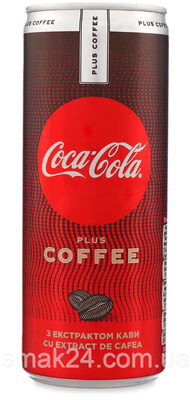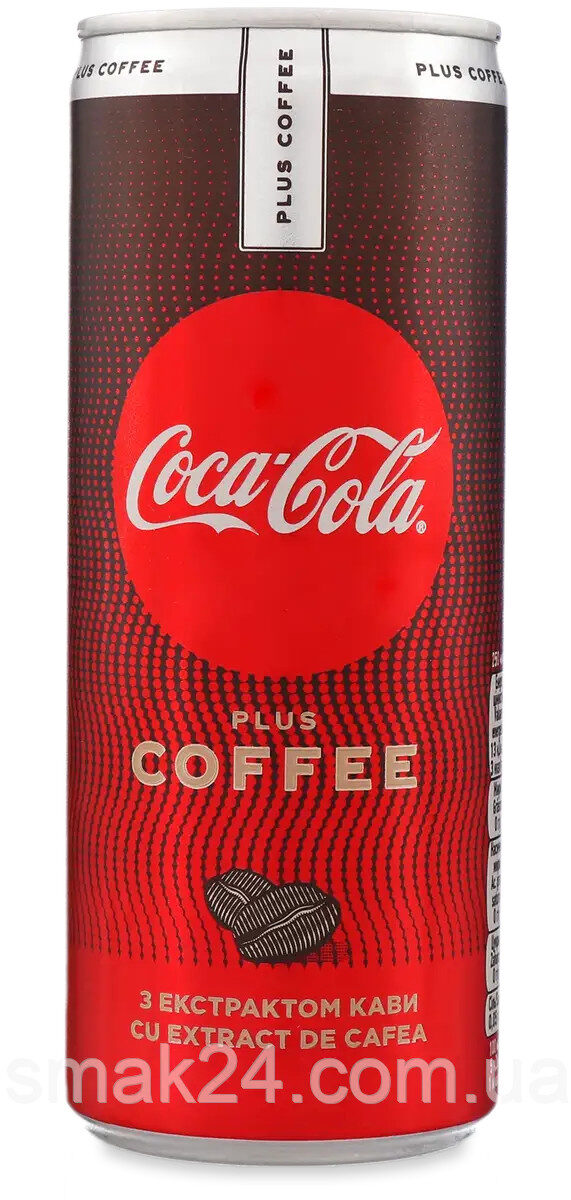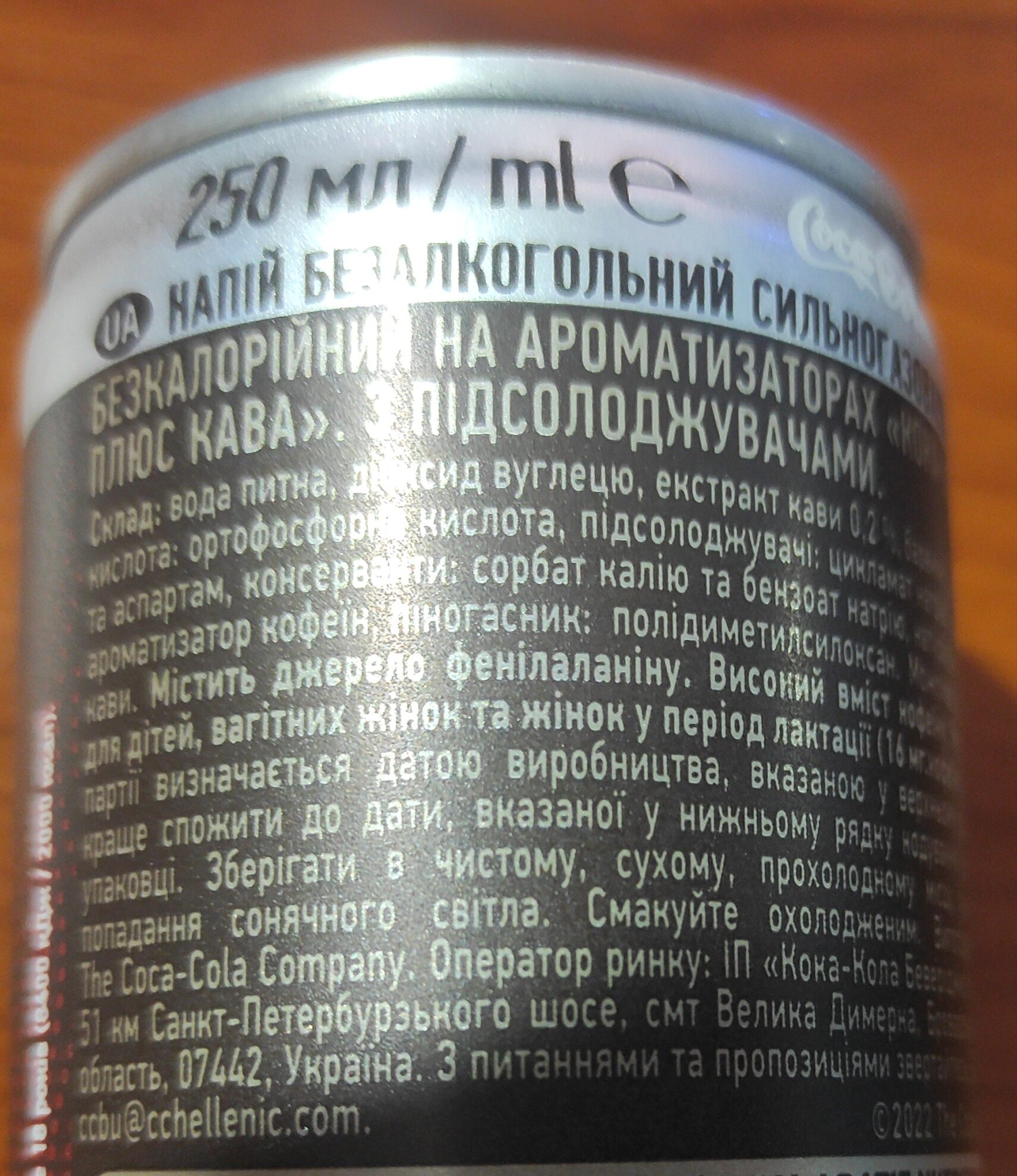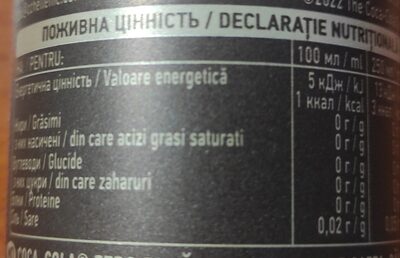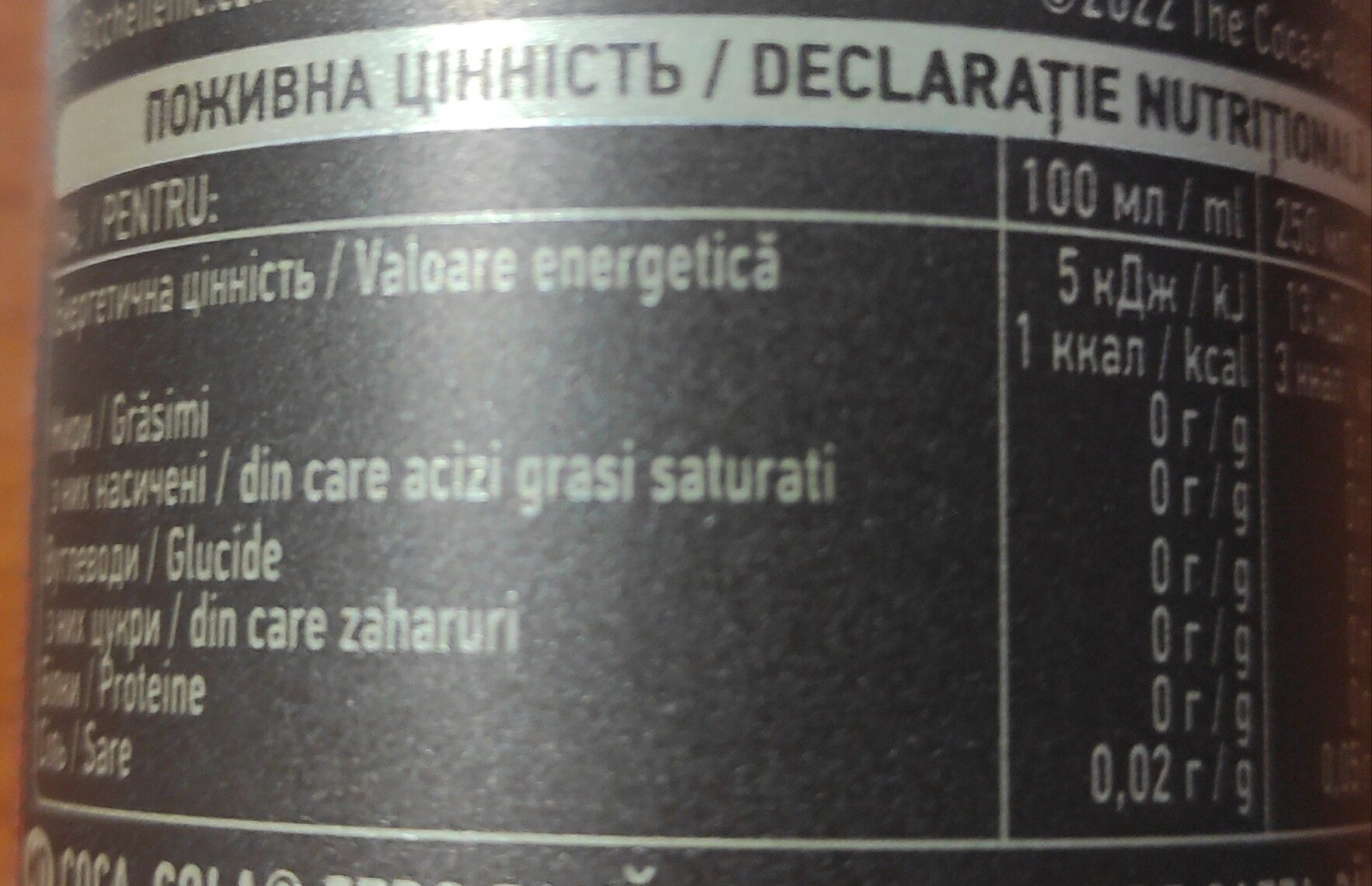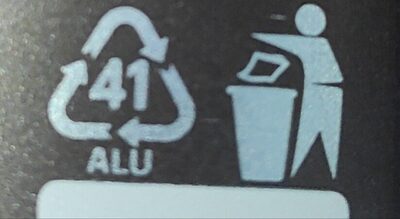Ajuda'ns a fer que la transparència alimentària sigui la norma!
Com a organització sense ànim de lucre, depenem de les vostres donacions per continuar informant els consumidors de tot el món sobre tot allò què mengen.
La revolució alimentària comença amb tu!
Coca-Cola plus Coffee - 250 ml
Coca-Cola plus Coffee - 250 ml
Aquesta pàgina del producte no està completa. Podeu ajudar a completar-la editant-la i afegint-hi més dades a partir de les fotos ja disponibles, o fent-ne més amb l'aplicació de androide o iPhone / iPad. Gràcies!
×
Codi de barres: 5449000258243 (EAN / EAN-13)
Quantitat: 250 ml
Empaquetament: en:Metal, en:Recyclable Metals, Alumini, en:Can
Marques: Coca-Cola
Categories: Begudes, Begudes carbonatades, Begudes ensucrades artificialment, Refrescs, es:Refresco
Matching with your preferences
Salut
Ingredients
-
26 ingredients
Anglès: Drinking water, carbon dioxide, coffee extract 0.2%, colorant: sugar color IV (E150d), acid: phosphoric acid (E338), sweeteners: sodium cyclamate (E952), acesulfame potassium (E950) and aspartame (E951), preservatives: potassium sorbate (E202) and sodium benzoate (E211), natural flavorings, caffeine flavor, antifoam: polydimethylsiloxane (E900).Rastres: es:contiene-una-fuente-de-fenilalanina
Processament d'aliments
-
Aliments ultra processats
Elements que indiquen que el producte està al grup 4 - Aliments i begudes ultraprocessats:
- Additiu: E150d
- Additiu: E290 - Diòxid de carboni
- Additiu: E900 - E900 food additive
- Additiu: E900a - Dimetilpolisiloxà
- Additiu: E950 - Acesulfam K
- Additiu: E951 - Aspartam
- Additiu: E952 - Àcid ciclàmic i les seves sals de sodi i calci
- Ingredient: Color
- Ingredient: Aromes
- Ingredient: Edulcorant
Els productes alimentaris es classifiquen en 4 grups segons el seu grau de processament:
- Aliments no processats o mínimament processats
- Ingredients culinaris processats
- Aliments processats
- Aliments ultra processats
La determinació del grup es fa en funció de la categoria del producte i dels ingredients que conté.
Additius
-
E202 - Sorbat de potassi
Potassium sorbate: Potassium sorbate is the potassium salt of sorbic acid, chemical formula CH3CH=CH−CH=CH−CO2K. It is a white salt that is very soluble in water -58.2% at 20 °C-. It is primarily used as a food preservative -E number 202-. Potassium sorbate is effective in a variety of applications including food, wine, and personal-care products. While sorbic acid is naturally occurring in some berries, virtually all of the world's production of sorbic acid, from which potassium sorbate is derived, is manufactured synthetically.Origen: Wikipedia (Anglès)
-
E211 - Benzoat de sodi
Sodium benzoate: Sodium benzoate is a substance which has the chemical formula NaC7H5O2. It is a widely used food preservative, with an E number of E211. It is the sodium salt of benzoic acid and exists in this form when dissolved in water. It can be produced by reacting sodium hydroxide with benzoic acid.Origen: Wikipedia (Anglès)
-
E290 - Diòxid de carboni
Carbon dioxide: Carbon dioxide -chemical formula CO2- is a colorless gas with a density about 60% higher than that of dry air. Carbon dioxide consists of a carbon atom covalently double bonded to two oxygen atoms. It occurs naturally in Earth's atmosphere as a trace gas. The current concentration is about 0.04% -410 ppm- by volume, having risen from pre-industrial levels of 280 ppm. Natural sources include volcanoes, hot springs and geysers, and it is freed from carbonate rocks by dissolution in water and acids. Because carbon dioxide is soluble in water, it occurs naturally in groundwater, rivers and lakes, ice caps, glaciers and seawater. It is present in deposits of petroleum and natural gas. Carbon dioxide is odorless at normally encountered concentrations, however, at high concentrations, it has a sharp and acidic odor.As the source of available carbon in the carbon cycle, atmospheric carbon dioxide is the primary carbon source for life on Earth and its concentration in Earth's pre-industrial atmosphere since late in the Precambrian has been regulated by photosynthetic organisms and geological phenomena. Plants, algae and cyanobacteria use light energy to photosynthesize carbohydrate from carbon dioxide and water, with oxygen produced as a waste product.CO2 is produced by all aerobic organisms when they metabolize carbohydrates and lipids to produce energy by respiration. It is returned to water via the gills of fish and to the air via the lungs of air-breathing land animals, including humans. Carbon dioxide is produced during the processes of decay of organic materials and the fermentation of sugars in bread, beer and wine making. It is produced by combustion of wood and other organic materials and fossil fuels such as coal, peat, petroleum and natural gas. It is an unwanted byproduct in many large scale oxidation processes, for example, in the production of acrylic acid -over 5 million tons/year-.It is a versatile industrial material, used, for example, as an inert gas in welding and fire extinguishers, as a pressurizing gas in air guns and oil recovery, as a chemical feedstock and as a supercritical fluid solvent in decaffeination of coffee and supercritical drying. It is added to drinking water and carbonated beverages including beer and sparkling wine to add effervescence. The frozen solid form of CO2, known as dry ice is used as a refrigerant and as an abrasive in dry-ice blasting. Carbon dioxide is the most significant long-lived greenhouse gas in Earth's atmosphere. Since the Industrial Revolution anthropogenic emissions – primarily from use of fossil fuels and deforestation – have rapidly increased its concentration in the atmosphere, leading to global warming. Carbon dioxide also causes ocean acidification because it dissolves in water to form carbonic acid.Origen: Wikipedia (Anglès)
-
E338 - Àcid fosfòric
Phosphoric acid: Phosphoric acid -also known as orthophosphoric acid or phosphoricV acid- is a weak acid with the chemical formula H3PO4. Orthophosphoric acid refers to phosphoric acid, which is the IUPAC name for this compound. The prefix ortho- is used to distinguish the acid from related phosphoric acids, called polyphosphoric acids. Orthophosphoric acid is a non-toxic acid, which, when pure, is a solid at room temperature and pressure. The conjugate base of phosphoric acid is the dihydrogen phosphate ion, H2PO−4, which in turn has a conjugate base of hydrogen phosphate, HPO2−4, which has a conjugate base of phosphate, PO3−4. Phosphates are essential for life.The most common source of phosphoric acid is an 85% aqueous solution; such solutions are colourless, odourless, and non-volatile. The 85% solution is a syrupy liquid, but still pourable. Although phosphoric acid does not meet the strict definition of a strong acid, the 85% solution is acidic enough to be corrosive. Because of the high percentage of phosphoric acid in this reagent, at least some of the orthophosphoric acid is condensed into polyphosphoric acids; for the sake of labeling and simplicity, the 85% represents H3PO4 as if it were all in the ortho form. Dilute aqueous solutions of phosphoric acid exist in the ortho form.Origen: Wikipedia (Anglès)
-
E900 - E900 food additive
Polydimethylsiloxane: Polydimethylsiloxane -PDMS- belongs to a group of polymeric organosilicon compounds that are commonly referred to as silicones. PDMS is the most widely used silicon-based organic polymer, and is particularly known for its unusual rheological -or flow- properties. PDMS is optically clear, and, in general, inert, non-toxic, and non-flammable. It is also called dimethylpolysiloxane or dimethicone and is one of several types of silicone oil -polymerized siloxane-. Its applications range from contact lenses and medical devices to elastomers; it is also present in shampoos -as dimethicone makes hair shiny and slippery-, food -antifoaming agent-, caulking, lubricants and heat-resistant tiles.Origen: Wikipedia (Anglès)
-
E900a - Dimetilpolisiloxà
Polydimethylsiloxane: Polydimethylsiloxane -PDMS- belongs to a group of polymeric organosilicon compounds that are commonly referred to as silicones. PDMS is the most widely used silicon-based organic polymer, and is particularly known for its unusual rheological -or flow- properties. PDMS is optically clear, and, in general, inert, non-toxic, and non-flammable. It is also called dimethylpolysiloxane or dimethicone and is one of several types of silicone oil -polymerized siloxane-. Its applications range from contact lenses and medical devices to elastomers; it is also present in shampoos -as dimethicone makes hair shiny and slippery-, food -antifoaming agent-, caulking, lubricants and heat-resistant tiles.Origen: Wikipedia (Anglès)
-
E950 - Acesulfam K
Acesulfame potassium: Acesulfame potassium - AY-see-SUL-faym-, also known as acesulfame K -K is the symbol for potassium- or Ace K, is a calorie-free sugar substitute -artificial sweetener- often marketed under the trade names Sunett and Sweet One. In the European Union, it is known under the E number -additive code- E950. It was discovered accidentally in 1967 by German chemist Karl Clauss at Hoechst AG -now Nutrinova-. In chemical structure, acesulfame potassium is the potassium salt of 6-methyl-1‚2,3-oxathiazine-4-3H--one 2‚2-dioxide. It is a white crystalline powder with molecular formula C4H4KNO4S and a molecular weight of 201.24 g/mol.Origen: Wikipedia (Anglès)
-
E951 - Aspartam
Aspartame: Aspartame -APM- is an artificial non-saccharide sweetener used as a sugar substitute in some foods and beverages. In the European Union, it is codified as E951. Aspartame is a methyl ester of the aspartic acid/phenylalanine dipeptide. A panel of experts set up by the European Food Safety Authority concluded in 2013 that aspartame is safe for human consumption at current levels of exposure. As of 2018, evidence does not support a long-term benefit for weight loss or in diabetes. Because its breakdown products include phenylalanine, people with the genetic condition phenylketonuria -PKU- must be aware of this as an additional source.It was first sold under the brand name NutraSweet. It was first made in 1965, and the patent expired in 1992. It was initially approved for use in food products by the U.S. Food and Drug Administration -FDA- in 1981. The safety of aspartame has been the subject of several political and medical controversies, United States congressional hearings, and Internet hoaxes.Origen: Wikipedia (Anglès)
-
E952 - Àcid ciclàmic i les seves sals de sodi i calci
Cyclamic acid: Cyclamic acid is a compound with formula C6H13NO3S. It is included in E number "E952". Cyclamic acid is mainly used as catalyst in the production of paints and plastics, and furthermore as a reagent for laboratory usage.The sodium and calcium salts of cyclamic acid are used as artificial sweeteners under the name cyclamate.Origen: Wikipedia (Anglès)
Anàlisi dels ingredients
-
No conté oli de palma
No s'han detectat ingredients que continguin oli de palma
Ingredients no reconeguts: en:sugar-color-iv, en:caffeine-flavor, en:antifoamAlguns ingredients no s'han pogut reconèixer.
Necessitem la teva ajuda!
Podeu ajudar-nos a reconèixer més ingredients i analitzar millor la llista d'ingredients d'aquest producte i d'altres mitjançant:
- Editeu aquesta pàgina de producte per corregir les faltes d’ortografia de la llista d’ingredients i/o per eliminar els ingredients d’altres idiomes i frases que no estiguin relacionades amb els ingredients.
- Afegiu entrades, sinònims o traduccions noves a les nostres llistes multilingües d’ingredients, mètodes de processament d’ingredients i etiquetes.
Uniu-vos al canal #ingredients del nostre espai de discussió a Slack i/o apreneu sobre l'anàlisi dels ingredients en la nostra wiki, si voleu ajudar. Gràcies!
-
Es desconeix si és vegà
Ingredients no reconeguts: en:sugar-color-iv, en:caffeine-flavor, en:antifoamAlguns ingredients no s'han pogut reconèixer.
Necessitem la teva ajuda!
Podeu ajudar-nos a reconèixer més ingredients i analitzar millor la llista d'ingredients d'aquest producte i d'altres mitjançant:
- Editeu aquesta pàgina de producte per corregir les faltes d’ortografia de la llista d’ingredients i/o per eliminar els ingredients d’altres idiomes i frases que no estiguin relacionades amb els ingredients.
- Afegiu entrades, sinònims o traduccions noves a les nostres llistes multilingües d’ingredients, mètodes de processament d’ingredients i etiquetes.
Uniu-vos al canal #ingredients del nostre espai de discussió a Slack i/o apreneu sobre l'anàlisi dels ingredients en la nostra wiki, si voleu ajudar. Gràcies!
-
Es desconeix si és vegetarià
Ingredients no reconeguts: en:sugar-color-iv, en:caffeine-flavor, en:antifoamAlguns ingredients no s'han pogut reconèixer.
Necessitem la teva ajuda!
Podeu ajudar-nos a reconèixer més ingredients i analitzar millor la llista d'ingredients d'aquest producte i d'altres mitjançant:
- Editeu aquesta pàgina de producte per corregir les faltes d’ortografia de la llista d’ingredients i/o per eliminar els ingredients d’altres idiomes i frases que no estiguin relacionades amb els ingredients.
- Afegiu entrades, sinònims o traduccions noves a les nostres llistes multilingües d’ingredients, mètodes de processament d’ingredients i etiquetes.
Uniu-vos al canal #ingredients del nostre espai de discussió a Slack i/o apreneu sobre l'anàlisi dels ingredients en la nostra wiki, si voleu ajudar. Gràcies!
-
Detalls de l'anàlisi dels ingredients
Necessitem la teva ajuda!
Alguns ingredients no s'han pogut reconèixer.
Necessitem la teva ajuda!
Podeu ajudar-nos a reconèixer més ingredients i analitzar millor la llista d'ingredients d'aquest producte i d'altres mitjançant:
- Editeu aquesta pàgina de producte per corregir les faltes d’ortografia de la llista d’ingredients i/o per eliminar els ingredients d’altres idiomes i frases que no estiguin relacionades amb els ingredients.
- Afegiu entrades, sinònims o traduccions noves a les nostres llistes multilingües d’ingredients, mètodes de processament d’ingredients i etiquetes.
Uniu-vos al canal #ingredients del nostre espai de discussió a Slack i/o apreneu sobre l'anàlisi dels ingredients en la nostra wiki, si voleu ajudar. Gràcies!
en: Drinking water, carbon dioxide, coffee 0.2%, colorant (sugar color IV (e150d)), acid (phosphoric acid (e338)), sweeteners (sodium cyclamate (e952)), acesulfame potassium (e950), aspartame (e951), preservatives (potassium sorbate (e202)), sodium benzoate (e211), natural flavorings, caffeine flavor, antifoam (polydimethylsiloxane (e900))- Drinking water -> en:water - vegan: yes - vegetarian: yes - ciqual_food_code: 18066 - percent_min: 47.9 - percent_max: 99.6
- carbon dioxide -> en:e290 - vegan: yes - vegetarian: yes - percent_min: 0.2 - percent_max: 49.9
- coffee -> en:coffee - vegan: yes - vegetarian: yes - ciqual_proxy_food_code: 18003 - percent_min: 0.2 - percent: 0.2 - percent_max: 0.2
- colorant -> en:colour - percent_min: 0 - percent_max: 0.2
- sugar color IV -> en:sugar-color-iv - percent_min: 0 - percent_max: 0.2
- e150d -> en:e150d - vegan: yes - vegetarian: yes - percent_min: 0 - percent_max: 0.2
- sugar color IV -> en:sugar-color-iv - percent_min: 0 - percent_max: 0.2
- acid -> en:acid - percent_min: 0 - percent_max: 0.2
- phosphoric acid -> en:e338 - vegan: yes - vegetarian: yes - percent_min: 0 - percent_max: 0.2
- e338 -> en:e338 - vegan: yes - vegetarian: yes - percent_min: 0 - percent_max: 0.2
- phosphoric acid -> en:e338 - vegan: yes - vegetarian: yes - percent_min: 0 - percent_max: 0.2
- sweeteners -> en:sweetener - percent_min: 0 - percent_max: 0.2
- sodium cyclamate -> en:e952 - vegan: yes - vegetarian: yes - percent_min: 0 - percent_max: 0.2
- e952 -> en:e952 - vegan: yes - vegetarian: yes - percent_min: 0 - percent_max: 0.2
- sodium cyclamate -> en:e952 - vegan: yes - vegetarian: yes - percent_min: 0 - percent_max: 0.2
- acesulfame potassium -> en:e950 - vegan: yes - vegetarian: yes - percent_min: 0 - percent_max: 0.2
- e950 -> en:e950 - vegan: yes - vegetarian: yes - percent_min: 0 - percent_max: 0.2
- aspartame -> en:e951 - vegan: yes - vegetarian: yes - percent_min: 0 - percent_max: 0.2
- e951 -> en:e951 - vegan: yes - vegetarian: yes - percent_min: 0 - percent_max: 0.2
- preservatives -> en:preservative - percent_min: 0 - percent_max: 0.2
- potassium sorbate -> en:e202 - vegan: yes - vegetarian: yes - percent_min: 0 - percent_max: 0.2
- e202 -> en:e202 - vegan: yes - vegetarian: yes - percent_min: 0 - percent_max: 0.2
- potassium sorbate -> en:e202 - vegan: yes - vegetarian: yes - percent_min: 0 - percent_max: 0.2
- sodium benzoate -> en:e211 - vegan: yes - vegetarian: yes - percent_min: 0 - percent_max: 0.2
- e211 -> en:e211 - vegan: yes - vegetarian: yes - percent_min: 0 - percent_max: 0.2
- natural flavorings -> en:natural-flavouring - vegan: maybe - vegetarian: maybe - percent_min: 0 - percent_max: 0.2
- caffeine flavor -> en:caffeine-flavor - percent_min: 0 - percent_max: 0.2
- antifoam -> en:antifoam - percent_min: 0 - percent_max: 0.2
- polydimethylsiloxane -> en:e900a - vegan: yes - vegetarian: yes - percent_min: 0 - percent_max: 0.2
- e900 -> en:e900 - vegan: yes - vegetarian: yes - percent_min: 0 - percent_max: 0.2
- polydimethylsiloxane -> en:e900a - vegan: yes - vegetarian: yes - percent_min: 0 - percent_max: 0.2
Nutrició
-
Bona qualitat nutricional
⚠ ️Atenció: la quantitat de fruita, verdura i fruits secs no s'especifica a l'etiqueta, s'ha fet una estimació a partir de la llista d'ingredients: 0Aquest producte es considera una beguda per al càlcul de la Nutri-Score.
Punts positius: 0
- Proteïnes: 0 / 5 (valor: 0, valor arrodonit: 0)
- Fibra: 0 / 5 (valor: 0, valor arrodonit: 0)
- Fruites, verdures, fruits secs i olis de colza/nou/oliva: 0 / 10 (valor: 0, valor arrodonit: 0)
Punts negatius: 1
- Energia: 1 / 10 (valor: 5, valor arrodonit: 5)
- Sucres: 0 / 10 (valor: 0, valor arrodonit: 0)
- Greixos saturats: 0 / 10 (valor: 0, valor arrodonit: 0)
- Sodi: 0 / 10 (valor: 80, valor arrodonit: 80)
Els punts per proteïnes es compten perquè els punts negatius són inferiors a 11.
Puntuació nutricional: (1 - 0)
Nutri-Score:
-
Nivells de nutrients
-
Greix en baixa quantitat (0%)
Què us cal saber- Un alt consum de greixos, especialment de greixos saturats, pot augmentar el colesterol, que augmenta el risc de patir malalties del cor.
Recomanació: Reduïu el consum de greixos i greixos saturats- Trieu productes amb menys greixos i greixos saturats.
-
Àcid gras saturat en baixa quantitat (0%)
Què us cal saber- Un alt consum de greixos, especialment de greixos saturats, pot augmentar el colesterol, que augmenta el risc de patir malalties del cor.
Recomanació: Reduïu el consum de greixos i greixos saturats- Trieu productes amb menys greixos i greixos saturats.
-
Sucre en baixa quantitat (0%)
Què us cal saber- Un alt consum de sucre pot provocar augment de pes i càries dental. També augmenta el risc de patir diabetis tipus 2 i malalties cardiovasculars.
Recomanació: Limitau el consum de sucre i de begudes ensucrades- Les begudes ensucrades (com ara refrescos, begudes de fruites i sucs i nèctars de fruites) s'han de limitar tant com sigui possible (no més d'1 got al dia).
- Triau productes amb menor contingut de sucre i reduïu el consum de productes amb sucres afegits.
-
Sal comuna en Quantitat moderada (0.2%)
Què us cal saber- Un alt consum de sal (o sodi) pot provocar un augment de la pressió arterial, que pot augmentar el risc de patir malalties del cor i ictus.
- Moltes persones que tenen hipertensió no ho saben, ja que sovint no en tenen símptomes.
- La majoria de la gent consumeix massa sal (de 9 a 12 grams de mitjana al dia), al voltant del doble del nivell màxim d'ingesta recomanat.
Recomanació: Limitau la ingesta de sal i d'aliments rics en sal- Reduïu la sal que emprau quan cuinau, i no afegiu sal a taula.
- Limiteu el consum d'aperitius salats i trieu productes amb menor contingut de sal.
-
-
Informació nutricional
Informació nutricional Com es ven
per 100 g/100 mlCom es ven
per porció (250 ml)Comparat amb: es:refresco Energia 5 kj
(1 kcal)12,5 kj
(2 kcal)-93% Greix 0 g 0 g -100% Àcid gras saturat 0 g 0 g -100% Hidrats de carboni 0 g 0 g -100% Sucre 0 g 0 g -100% Fiber ? ? Proteïna 0 g 0 g -100% Sal comuna 0,2 g 0,5 g +737% Fruits‚ vegetables‚ nuts and rapeseed‚ walnut and olive oils (estimate from ingredients list analysis) 0 % 0 %
Entorn
-
L'Eco-Score encara no s'aplica
Encara no s'aplica per a la categoria: Refrescs
L'Eco-Score encara no és aplicable per a aquesta categoria, però estem treballant per fer-ho possible.
Empaquetament
-
Embalatge de baix impacte
-
Peces d'embalatge
Can (Alumini)
-
Materials d'embalatge
Material % Pes de l'embalatge Pes de l'embalatge per 100 g de producte Metal
-
Transport
-
Orígens dels ingredients
Falta informació sobre l'origen dels ingredients
⚠ ️ L'origen dels ingredients d'aquest producte no està indicat.
Si estan indicats a l'embalatge, podeu modificar la fitxa del producte i afegir-los.
Si sou el fabricant d'aquest producte, podeu enviar-nos la informació amb la nostra plataforma gratuïta per a productors.Add the origins of ingredients for this product Add the origins of ingredients for this product
Report a problem
-
Incomplete or incorrect information?
Category, labels, ingredients, allergens, nutritional information, photos etc.
If the information does not match the information on the packaging, please complete or correct it. Open Food Facts is a collaborative database, and every contribution is useful for all.
Fonts de dades
Producte afegit per kiliweb
Última modificació de la pàgina del producte per stikyt.
La pàgina del producte, també editada per del51, ecoscore-impact-estimator, elcoco, foodless, jog13ovd, openfoodfacts-contributors, packbot, teolemon, yuka.WDZwWlFJWU5vOGhUaGZjNTh3dnk5ZEFyK0p1bFoxcU1lK1lOSVE9PQ, yuka.ZDZNT0w0NHc5OFkzeFBkZzRRTGFvc2t1NDQrUWV6eTdkclFZSVE9PQ, yuka.sY2b0xO6T85zoF3NwEKvlhd2QuHxnAztbxXfpWzV2-zVHM3XcdFQwbLQNag.
